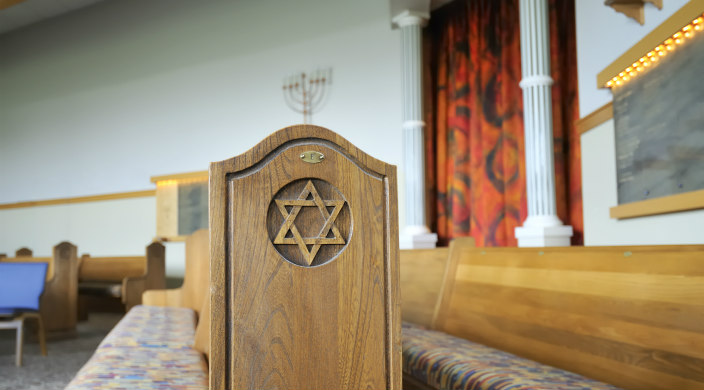
I was raised in a rural Catholic family of the 1950’s. My home parish was in the orchard-rich east bay town of Mission San Jose (now part of Fremont) and was one of the original California missions. I was taught by the nuns from age five. When high school came along I commuted by bus 90 minutes each way to San Jose to be taught by the Jesuits at Bellarmine.
For a traditional Catholic the term “conversion”—which was very much a part of our religious discussion—evokes three very different experiences. There is the blinding miraculous conversion like the one that turned Saul of Tarsus into St. Paul. There is the intellectual conversion where ideas lead inexorably to a new statement of faith, such as the 19th century conversion described by Oxford’s John Henry Newman, who came to Catholicism through the force of pure reason. And finally there is the garden-variety conversion-of-convenience where the more malleable, or less religiously committed spouse in a mixed marriage takes on the religion of the partner. So what kind of conversion is mine? Unfortunately, like a lot of neat distinctions, these categories of conversion fail me when I examine my own life—mostly because my life, and my Catholic beliefs, changed dramatically after I left high school.
At age 17 I applied for, and was accepted into, the Catholic religious order called the Society of Jesus, or more familiarly, the Jesuits. My experience as a Jesuit unmade my traditional Catholicism. This may come as surprise to people unfamiliar with Jesuits. To their great credit, Jesuits have always strongly believed in the transformative power of a thorough-going education in classics, philosophy, theology, and an individual’s preferred course of study—in my case, electrical engineering. The result of the Jesuit formation is not easy to predict—it can lead individuals back into traditional religious practices, others to radically progressive practices, others to leaving the Jesuit order, or leaving Catholicism, or leaving belief-systems totally. I myself left the order several years before final ordination to the priesthood. But not until I had a transformative experience—one that has had lasting impact on me and on this very conversion process.
It was 1967. I was at St. Louis University sitting in my room on a sunny afternoon doing some assigned reading for a Philosophy of Religion course. The book was Paul Tillich’s Dynamics of Faith. Tillich was a prominent Lutheran theologian, transplanted from Germany to the United States, and a Professor at the University of Chicago until his death in 1965. In words that I have reread many times, Tillich taught me something new about the meaning of Faith. I had been taught, and always assumed, that Faith is one and the same thing as Belief; that is, a person of Faith believes what is taught. This isn’t just a Catholic assumption; it is one that is deeply ingrained into our language. To “have faith” in something is to believe in it even, perhaps, in the face of evidence to the contrary. To “keep the faith” is to hang on to the beliefs we grew up with. When I was in high school we were always warned against secular universities where we would acquire new beliefs and “lose our faith”.
Paul Tillich had quite another view. He said that Faith is not so much believing things as it is being concerned about things, specifically about issues that are beyond our day-to-day crises and joys. Faith means that we make the effort, at least sometimes, to try to extend our horizon, and look further out for meaning, for purpose, for direction. And here’s the revelation: Tillich says that the way we exercise Faith is through Belief—and Doubt. The person of Faith—that person scanning the horizon—learns from his experiences, and comes to believe some things and to doubt others. As we learn more, we believe some things we used to doubt and doubt some things we used to believe. If not, we’re not really experiencing the world. To Paul Tillich, a person of unwavering belief would no more qualify as a person of Faith than would the nihilist that doubts all things.
This came as a stunning insight to me then. Here was a form of religious Faith that worked the way that my engineering thinking worked. Some challenge (maybe the design of a circuit or maybe the direction of my life) causes me to examine, question, think, and test until I can identify the beliefs—the truths, and the doubts—the non-truths that inform my response to the challenge.
I’ve reflected on Tillich’s passage for many years and I’ve added a metaphor to it that has helped me to further internalize his insight. This metaphor is based on a very cool conjunction of meanings around the word for ‘soul’ that occurs in several early languages. In Latin and Greek, and more recently I’ve learned in Hebrew as well, the roots for the word soul or spirit also means breath, and wind. The Latin anima, the Greek pneuma, the Hebrew ruach all share these same associations—soul/breath/wind. It’s not totally surprising perhaps—breath is a kind of wind. And both breath and wind are invisible things that can be felt—hence, their association with spirit.
Now let me stir in the Tillich lesson. I believe that Faith is to the life of the soul as breathing is to the life of the body. It is the animating principle. Believing is like inhaling—taking into ourselves sustenance. Doubting is like exhaling—letting go of the material that’s no longer useful, and is, quite literally, exhausted. The person whose faith is alive ‘breathes’—absorbing and expelling, believing and doubting. No one can only inhale and survive. No one can only exhale and survive. And no one can simply stop breathing.
This insight has been a major factor in my life. But on its own it didn’t bring me to Judaism. It did however free me to go a-wandering, which I certainly have done. I reflected on it as I left the Jesuits to explore the wider world. I reflected on it again when I entered a marriage and again when that marriage ended in great pain 15 years later.
And it was firmly planted into my personality when I finally encountered Judaism. I was brought to Judaism by Barbara Bernstein, whom I met 18 years ago, rapidly fell in love with and subsequently married. So am I one of those mixed-faith marriage converts after all—a convert-of-convenience?
I’ve questioned myself about this more than once. Was I the more malleable partner? (Probably) Was I less religiously committed? (Probably not) I asked myself: “What if I had met a Lutheran woman, or a Zoroastrian, or a Scientologist? Would I have gone wherever I was tugged?”
I have an answer to this that has now become one of my beliefs (inhale). The answer is simple. I didn’t fall in love with a Lutheran or a Zoroastrian or a Scientologist. I fell in love with a Jew. At least in part what I was loving here was Jewishness, though I didn’t realize it yet. I didn’t know many Jews. Here are some of her qualities that attracted me: she is smart—not just smart as in educated, but mentally acute. She’s funny, sometimes to irreverence. She’s aggressive; she’s challenging. She’s devoted to her family and fiercely devoted to her daughter. Yet she has a devout, even sentimental streak when it comes to prayer, liturgy, and her approach to God’s power.
I came to understand later that much of what I love about Barbara are qualities shared among many Jews. I started meeting lots of them. First I met her terrific almost-four-year-old daughter—later our mutual daughter. Then I met her family, her extended family, her friends. Then her former rabbi, Arnold Jacob Wolf. Then we joined a wonderful chavurah (group of friends) of families with young children, which has been a major part of our Jewish life for over a decade. Finally, as the children moved up through religious school, we blended into this larger temple community.
What I found is that Am Israel (the People of Israel) has many of the same qualities I found in Barbara. As a people, Jews are educated, canny, funny, blunt, aggressive, challenging, devoted to family, devoted to ritual. (Note well: I still think Barbara is the best of the lot).
And there’s another thing. Judaism, at least the Reform Judaism that I know, allows me to spiritually ‘breathe’, as I’ve discussed it here. Belief? Fine. Doubt? Fine. Not all religions are as tolerant of differing beliefs as Judaism is. In fact, as I understand it, our mandate as Reform Jews requires us to remember that Faith equals Concern, and that our experience of life requires us to continually evaluate our relation to God, our relation to one another, our very Jewishness.
This tolerance for a diversity of beliefs is widely affirmed by Reform Jews. But is it authentically Jewish? Some people say this is just Reform Judaism with its anything-goes attitude. My sense of it is that Judaism, from start to finish, is more sketchy than concrete.
Case in point: this year Barbara and I have taken Rabbi Kushner’s Hebrew class. It’s been a wonderful experience. From class one we’ve been immersed in the Hebrew Torah. Going very slowly and with lots of help, we’ve been able to look at short but crucial passages and I’ve been continually surprised. The Hebrew Bible is much different from any translation I’ve seen. Unexpectedly, it says far less than the translation.
Let me give just one example—the famous scene when Jacob wrestles the angel. Is it a good angel, a bad angel, maybe Esau’s guardian angel? The Torah says none of this. In just 6 Hebrew words the Torah says, roughly: “And Jacob remained alone and a man wrestled with him until the coming of dawn.” No angel, just ish, man. And the word wrestle could be “raise dust with”, “roll in the dust with”, “embrace”, “get in a dust-up with”. There’s plenty of blanks to fill in here.
Everything about the Hebrew Torah I’ve seen has been indistinct, shadowy, elliptical, suggestive—as if specificity itself was an idol to be shunned. Of course, the ultimate example of ellipticity in Judaism is the very name of God himself. He’s usually only referred to by his attributes. Even the tetragrammaton, the yud-heh-vav-heh, is a construction. Pronounced as it’s spelled, it’s voiceless and comes out not unlike the sound of breathing. Even though everything in our human consciousness craves specifics, the Torah tells us God’s name is not for hearing, his face is not for seeing lest we die, and maybe we can just barely survive seeing his afterglow once he’s passed.
Would a religion that forbids concrete representations of spiritual beings go on to require concrete representations of specific beliefs? Or would it instead tolerate, in fact require, that our collective beliefs and practices be vague, to be filled in only by the living of our individual lives. We return full circle. Judaism—our Judaism—is a religion that requires spiritual breathing, a life of faith that sometimes believes, sometimes doubts, but always learns.
So what kind of a convert am I? I’m not a convert with a miraculous vision. I think these are very rare, and then are hard to distinguish from psychosis. And I’m not, like Newman, a convert of the intellect, although I’m interested in the intellectual side to religion.
I think I’m the most typical kind of convert. I’m among the converts who somehow, sometime, find that they have settled into a community that they recognize and that recognizes them, a community that they appreciate, with whom they share values, where they can raise children, that allows them to spiritually breathe. This folding into the community is a slow and gentle process. Then one day you realize that the actual conversion, the t’shuvah (the turning) has happened long since.

